The US Banking Sector: Structure, Conduct, and Performance Analysis
VerifiedAdded on 2019/09/23
|22
|4171
|453
Report
AI Summary
This report provides a comprehensive analysis of the US banking sector, focusing on the Structure, Conduct, and Performance (SCP) framework. It examines the market structure, including concentration ratios and the Herfindahl-Hirschman Index (HHI), to understand the level of competition. The report delves into the conduct of banks, such as advertising, R&D, and selling efforts, and their impact on financial performance. It also assesses the performance of banks through profitability measures like return on equity (ROE) and cost efficiency. The analysis highlights the relationship between market structure, bank strategies, and financial outcomes, including revenue growth. The report acknowledges the dynamic nature of the US banking market and limitations of the SCP framework, offering insights into the competitive landscape and the factors influencing bank performance.

1
Running head: Markets and competition
Structure, Conduct and Performance of US
Banking Sector
Running head: Markets and competition
Structure, Conduct and Performance of US
Banking Sector
Paraphrase This Document
Need a fresh take? Get an instant paraphrase of this document with our AI Paraphraser
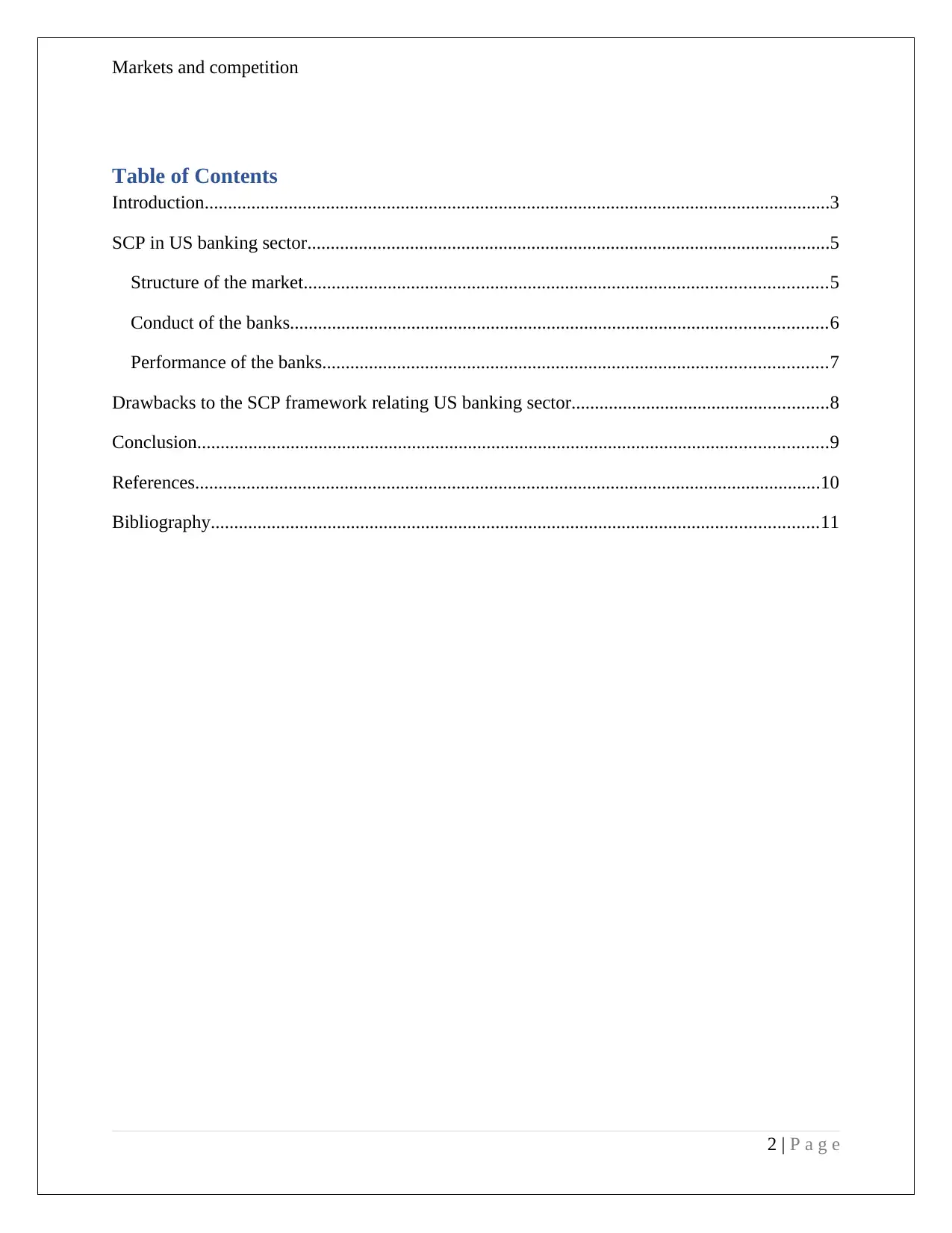
Markets and competition
Table of Contents
Introduction......................................................................................................................................3
SCP in US banking sector................................................................................................................5
Structure of the market................................................................................................................5
Conduct of the banks...................................................................................................................6
Performance of the banks............................................................................................................7
Drawbacks to the SCP framework relating US banking sector.......................................................8
Conclusion.......................................................................................................................................9
References......................................................................................................................................10
Bibliography..................................................................................................................................11
2 | P a g e
Table of Contents
Introduction......................................................................................................................................3
SCP in US banking sector................................................................................................................5
Structure of the market................................................................................................................5
Conduct of the banks...................................................................................................................6
Performance of the banks............................................................................................................7
Drawbacks to the SCP framework relating US banking sector.......................................................8
Conclusion.......................................................................................................................................9
References......................................................................................................................................10
Bibliography..................................................................................................................................11
2 | P a g e

Markets and competition
Introduction
The plan of the assignment is to analyse the rivalry and concentration in the United State’s
banking sector. This is critically made by examination of price-concentration relationship in
terms of the banking sector of the US industry. The assignment will follow along with the lines
of Berger and Hannan (1989), who studied US banking industry in the particular way as well as
Okeahalam (1998), who considered price-concentration relationship in South Africa. The US
banking sector took a new length with the beginning of its economic reforms in relation to
specific policies and regulation since the business year 1990. The main strategies useful by the
banks under the competitive business circumstances incorporates distinct products and services,
strategic marketing such as advertising, broadening customer base by promotional activities as
well as diversification to reduce the risk of operation, mergers and acquisitions in order to
consolidate the business and increase competence as well as joint ventures with the international
banks for enhancing capital base and efficient management. The policy and regulatory
framework changes brought by the US government significantly brought huge competition in the
market while enhancing the efficiency of the banks. This significantly raised several issues and
affected the arrangement of the market in US banking sector. The regulatory roles which have to
be made by the banks such as JPMorgan Chase are to sustain the competitive market and
enhance the competence of the banks. The rationale rising behind this problem slander in the
structure-conduct-performance (SCP) relationships developed by Mason (1939), significantly
proposed that the likelihood of collusive behavior critically enhances when the market is
concentrated with few firms. This, in turn, states that greater the market concentration, the more
the firm can earn profitability. The SCP relationships in US banking sector are well identified in
3 | P a g e
Introduction
The plan of the assignment is to analyse the rivalry and concentration in the United State’s
banking sector. This is critically made by examination of price-concentration relationship in
terms of the banking sector of the US industry. The assignment will follow along with the lines
of Berger and Hannan (1989), who studied US banking industry in the particular way as well as
Okeahalam (1998), who considered price-concentration relationship in South Africa. The US
banking sector took a new length with the beginning of its economic reforms in relation to
specific policies and regulation since the business year 1990. The main strategies useful by the
banks under the competitive business circumstances incorporates distinct products and services,
strategic marketing such as advertising, broadening customer base by promotional activities as
well as diversification to reduce the risk of operation, mergers and acquisitions in order to
consolidate the business and increase competence as well as joint ventures with the international
banks for enhancing capital base and efficient management. The policy and regulatory
framework changes brought by the US government significantly brought huge competition in the
market while enhancing the efficiency of the banks. This significantly raised several issues and
affected the arrangement of the market in US banking sector. The regulatory roles which have to
be made by the banks such as JPMorgan Chase are to sustain the competitive market and
enhance the competence of the banks. The rationale rising behind this problem slander in the
structure-conduct-performance (SCP) relationships developed by Mason (1939), significantly
proposed that the likelihood of collusive behavior critically enhances when the market is
concentrated with few firms. This, in turn, states that greater the market concentration, the more
the firm can earn profitability. The SCP relationships in US banking sector are well identified in
3 | P a g e
⊘ This is a preview!⊘
Do you want full access?
Subscribe today to unlock all pages.

Trusted by 1+ million students worldwide
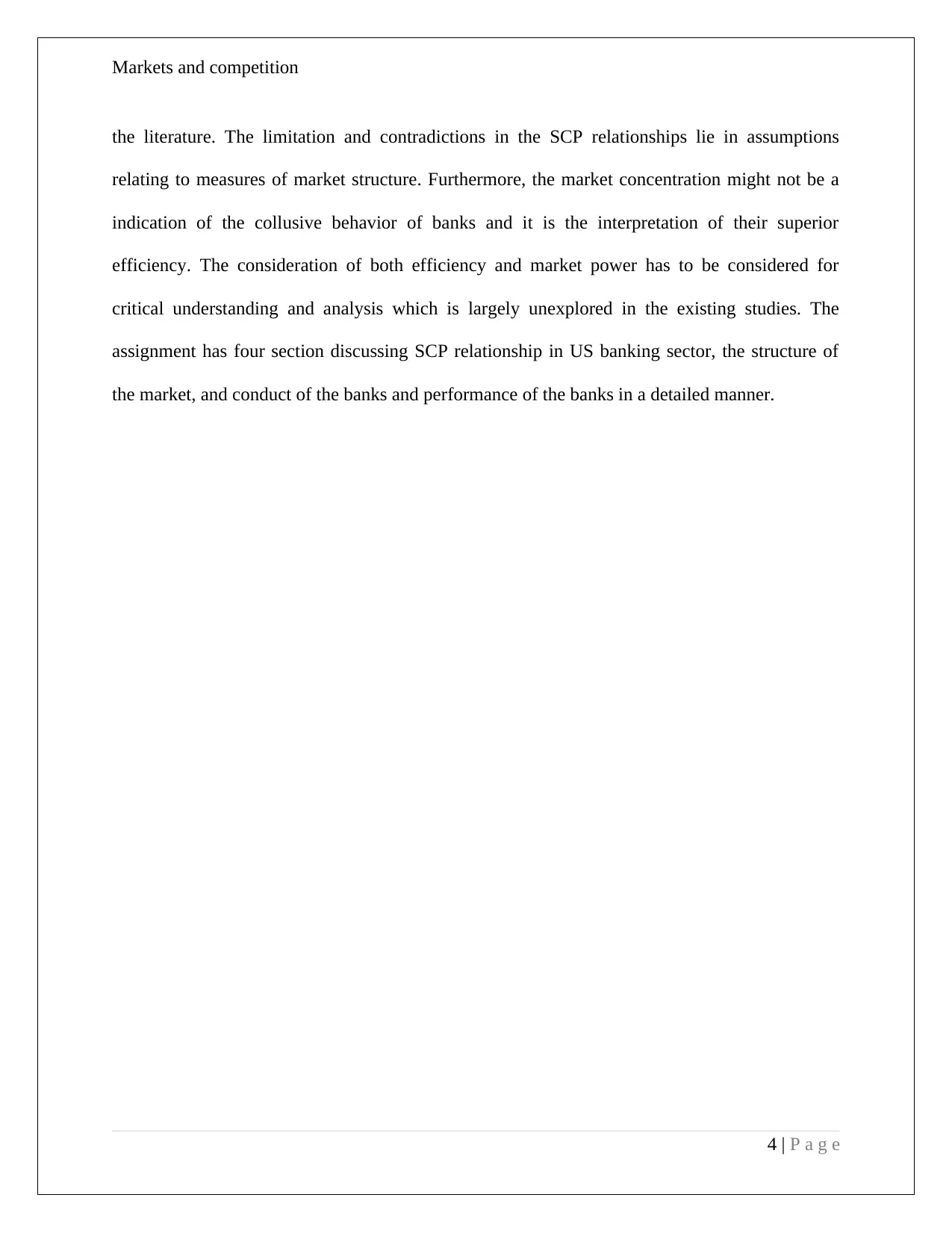
Markets and competition
the literature. The limitation and contradictions in the SCP relationships lie in assumptions
relating to measures of market structure. Furthermore, the market concentration might not be a
indication of the collusive behavior of banks and it is the interpretation of their superior
efficiency. The consideration of both efficiency and market power has to be considered for
critical understanding and analysis which is largely unexplored in the existing studies. The
assignment has four section discussing SCP relationship in US banking sector, the structure of
the market, and conduct of the banks and performance of the banks in a detailed manner.
4 | P a g e
the literature. The limitation and contradictions in the SCP relationships lie in assumptions
relating to measures of market structure. Furthermore, the market concentration might not be a
indication of the collusive behavior of banks and it is the interpretation of their superior
efficiency. The consideration of both efficiency and market power has to be considered for
critical understanding and analysis which is largely unexplored in the existing studies. The
assignment has four section discussing SCP relationship in US banking sector, the structure of
the market, and conduct of the banks and performance of the banks in a detailed manner.
4 | P a g e
Paraphrase This Document
Need a fresh take? Get an instant paraphrase of this document with our AI Paraphraser
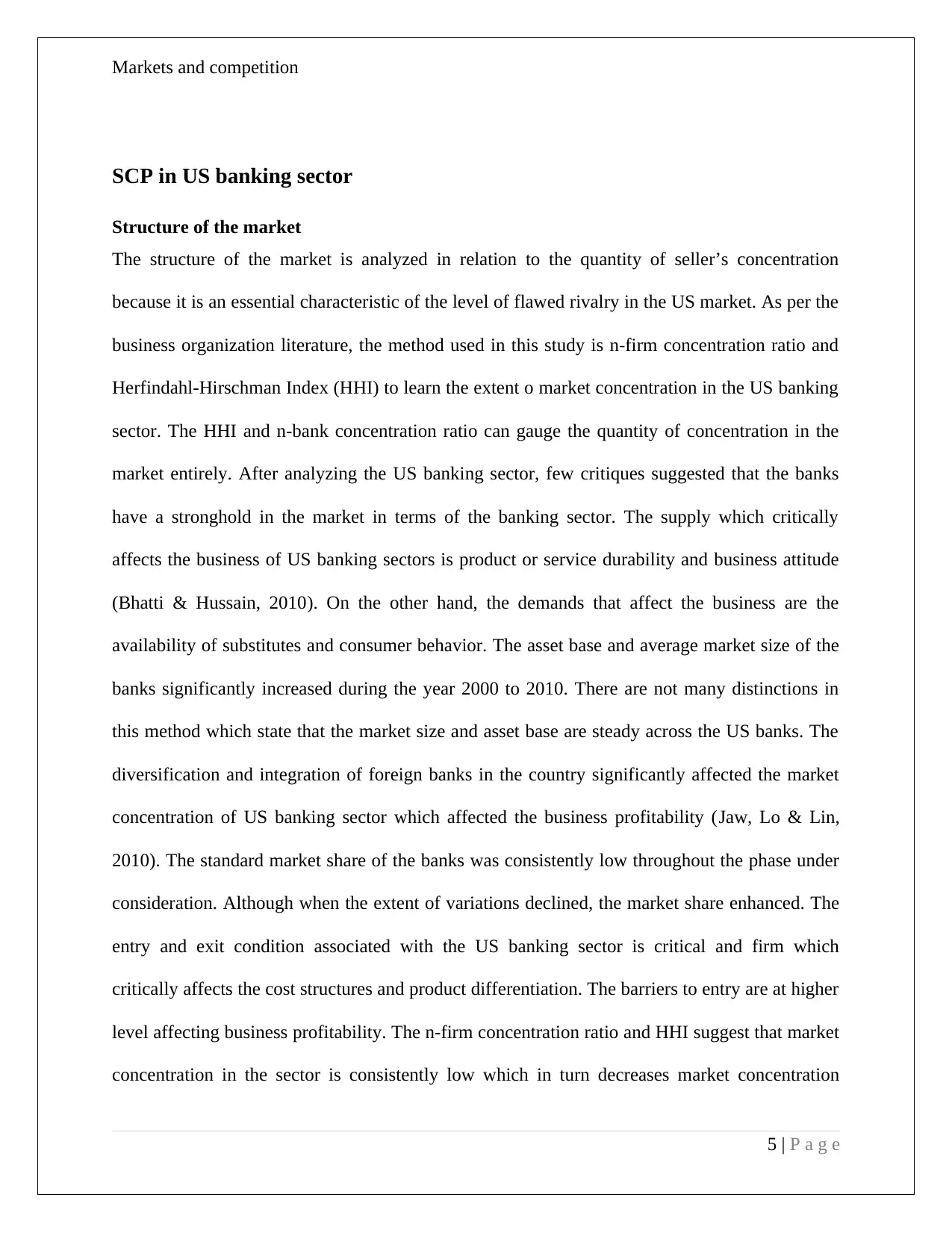
Markets and competition
SCP in US banking sector
Structure of the market
The structure of the market is analyzed in relation to the quantity of seller’s concentration
because it is an essential characteristic of the level of flawed rivalry in the US market. As per the
business organization literature, the method used in this study is n-firm concentration ratio and
Herfindahl-Hirschman Index (HHI) to learn the extent o market concentration in the US banking
sector. The HHI and n-bank concentration ratio can gauge the quantity of concentration in the
market entirely. After analyzing the US banking sector, few critiques suggested that the banks
have a stronghold in the market in terms of the banking sector. The supply which critically
affects the business of US banking sectors is product or service durability and business attitude
(Bhatti & Hussain, 2010). On the other hand, the demands that affect the business are the
availability of substitutes and consumer behavior. The asset base and average market size of the
banks significantly increased during the year 2000 to 2010. There are not many distinctions in
this method which state that the market size and asset base are steady across the US banks. The
diversification and integration of foreign banks in the country significantly affected the market
concentration of US banking sector which affected the business profitability (Jaw, Lo & Lin,
2010). The standard market share of the banks was consistently low throughout the phase under
consideration. Although when the extent of variations declined, the market share enhanced. The
entry and exit condition associated with the US banking sector is critical and firm which
critically affects the cost structures and product differentiation. The barriers to entry are at higher
level affecting business profitability. The n-firm concentration ratio and HHI suggest that market
concentration in the sector is consistently low which in turn decreases market concentration
5 | P a g e
SCP in US banking sector
Structure of the market
The structure of the market is analyzed in relation to the quantity of seller’s concentration
because it is an essential characteristic of the level of flawed rivalry in the US market. As per the
business organization literature, the method used in this study is n-firm concentration ratio and
Herfindahl-Hirschman Index (HHI) to learn the extent o market concentration in the US banking
sector. The HHI and n-bank concentration ratio can gauge the quantity of concentration in the
market entirely. After analyzing the US banking sector, few critiques suggested that the banks
have a stronghold in the market in terms of the banking sector. The supply which critically
affects the business of US banking sectors is product or service durability and business attitude
(Bhatti & Hussain, 2010). On the other hand, the demands that affect the business are the
availability of substitutes and consumer behavior. The asset base and average market size of the
banks significantly increased during the year 2000 to 2010. There are not many distinctions in
this method which state that the market size and asset base are steady across the US banks. The
diversification and integration of foreign banks in the country significantly affected the market
concentration of US banking sector which affected the business profitability (Jaw, Lo & Lin,
2010). The standard market share of the banks was consistently low throughout the phase under
consideration. Although when the extent of variations declined, the market share enhanced. The
entry and exit condition associated with the US banking sector is critical and firm which
critically affects the cost structures and product differentiation. The barriers to entry are at higher
level affecting business profitability. The n-firm concentration ratio and HHI suggest that market
concentration in the sector is consistently low which in turn decreases market concentration
5 | P a g e
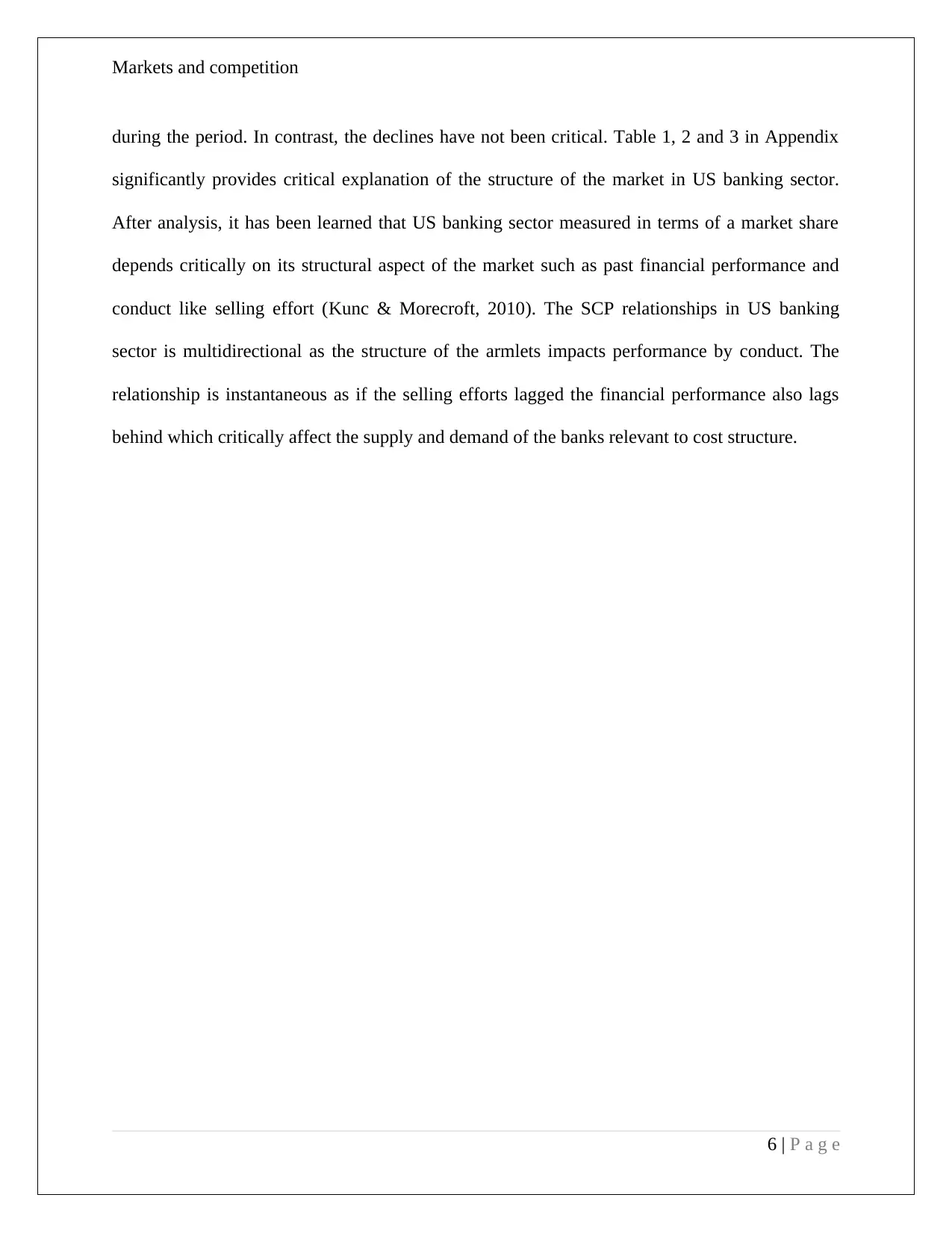
Markets and competition
during the period. In contrast, the declines have not been critical. Table 1, 2 and 3 in Appendix
significantly provides critical explanation of the structure of the market in US banking sector.
After analysis, it has been learned that US banking sector measured in terms of a market share
depends critically on its structural aspect of the market such as past financial performance and
conduct like selling effort (Kunc & Morecroft, 2010). The SCP relationships in US banking
sector is multidirectional as the structure of the armlets impacts performance by conduct. The
relationship is instantaneous as if the selling efforts lagged the financial performance also lags
behind which critically affect the supply and demand of the banks relevant to cost structure.
6 | P a g e
during the period. In contrast, the declines have not been critical. Table 1, 2 and 3 in Appendix
significantly provides critical explanation of the structure of the market in US banking sector.
After analysis, it has been learned that US banking sector measured in terms of a market share
depends critically on its structural aspect of the market such as past financial performance and
conduct like selling effort (Kunc & Morecroft, 2010). The SCP relationships in US banking
sector is multidirectional as the structure of the armlets impacts performance by conduct. The
relationship is instantaneous as if the selling efforts lagged the financial performance also lags
behind which critically affect the supply and demand of the banks relevant to cost structure.
6 | P a g e
⊘ This is a preview!⊘
Do you want full access?
Subscribe today to unlock all pages.

Trusted by 1+ million students worldwide
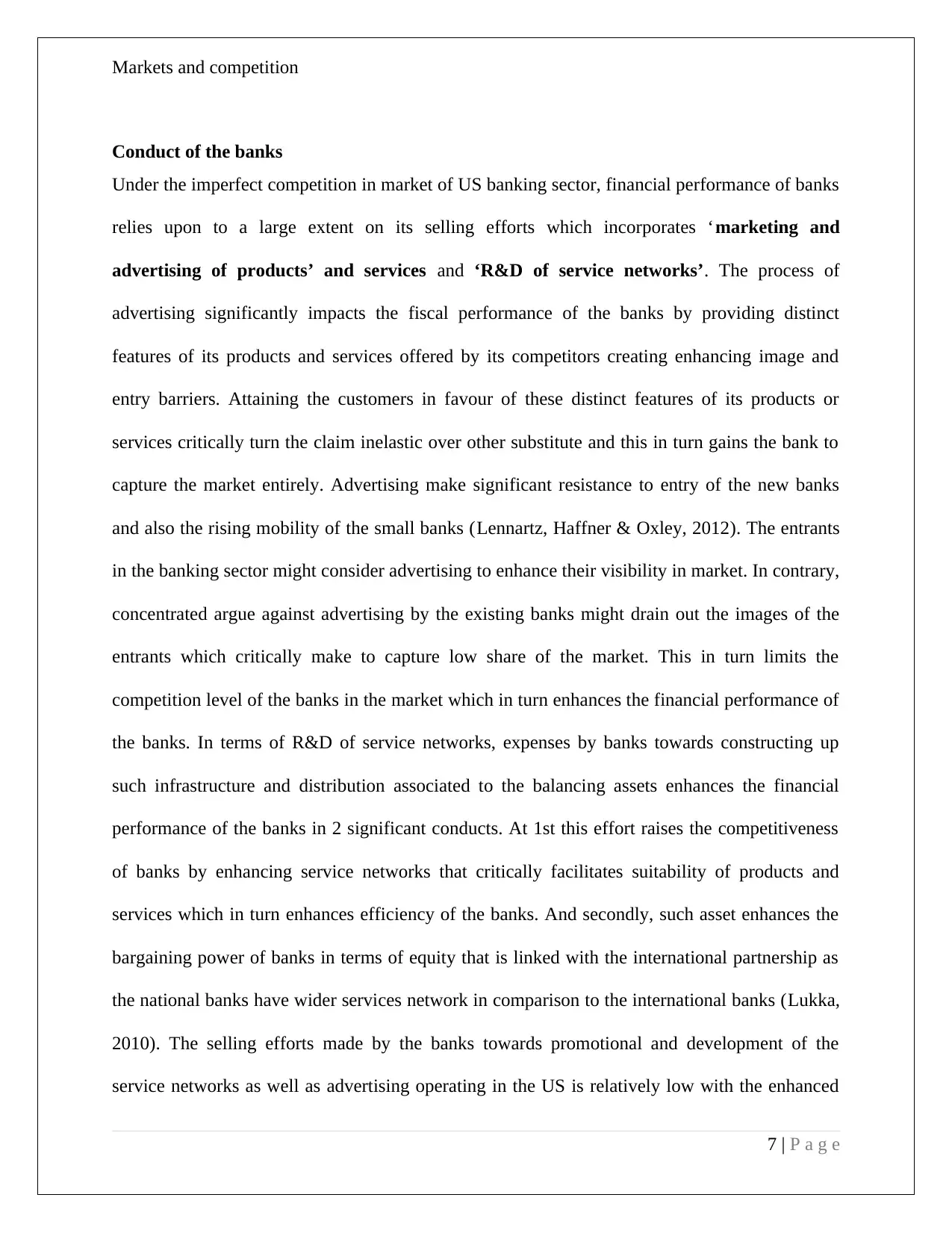
Markets and competition
Conduct of the banks
Under the imperfect competition in market of US banking sector, financial performance of banks
relies upon to a large extent on its selling efforts which incorporates ‘marketing and
advertising of products’ and services and ‘R&D of service networks’. The process of
advertising significantly impacts the fiscal performance of the banks by providing distinct
features of its products and services offered by its competitors creating enhancing image and
entry barriers. Attaining the customers in favour of these distinct features of its products or
services critically turn the claim inelastic over other substitute and this in turn gains the bank to
capture the market entirely. Advertising make significant resistance to entry of the new banks
and also the rising mobility of the small banks (Lennartz, Haffner & Oxley, 2012). The entrants
in the banking sector might consider advertising to enhance their visibility in market. In contrary,
concentrated argue against advertising by the existing banks might drain out the images of the
entrants which critically make to capture low share of the market. This in turn limits the
competition level of the banks in the market which in turn enhances the financial performance of
the banks. In terms of R&D of service networks, expenses by banks towards constructing up
such infrastructure and distribution associated to the balancing assets enhances the financial
performance of the banks in 2 significant conducts. At 1st this effort raises the competitiveness
of banks by enhancing service networks that critically facilitates suitability of products and
services which in turn enhances efficiency of the banks. And secondly, such asset enhances the
bargaining power of banks in terms of equity that is linked with the international partnership as
the national banks have wider services network in comparison to the international banks (Lukka,
2010). The selling efforts made by the banks towards promotional and development of the
service networks as well as advertising operating in the US is relatively low with the enhanced
7 | P a g e
Conduct of the banks
Under the imperfect competition in market of US banking sector, financial performance of banks
relies upon to a large extent on its selling efforts which incorporates ‘marketing and
advertising of products’ and services and ‘R&D of service networks’. The process of
advertising significantly impacts the fiscal performance of the banks by providing distinct
features of its products and services offered by its competitors creating enhancing image and
entry barriers. Attaining the customers in favour of these distinct features of its products or
services critically turn the claim inelastic over other substitute and this in turn gains the bank to
capture the market entirely. Advertising make significant resistance to entry of the new banks
and also the rising mobility of the small banks (Lennartz, Haffner & Oxley, 2012). The entrants
in the banking sector might consider advertising to enhance their visibility in market. In contrary,
concentrated argue against advertising by the existing banks might drain out the images of the
entrants which critically make to capture low share of the market. This in turn limits the
competition level of the banks in the market which in turn enhances the financial performance of
the banks. In terms of R&D of service networks, expenses by banks towards constructing up
such infrastructure and distribution associated to the balancing assets enhances the financial
performance of the banks in 2 significant conducts. At 1st this effort raises the competitiveness
of banks by enhancing service networks that critically facilitates suitability of products and
services which in turn enhances efficiency of the banks. And secondly, such asset enhances the
bargaining power of banks in terms of equity that is linked with the international partnership as
the national banks have wider services network in comparison to the international banks (Lukka,
2010). The selling efforts made by the banks towards promotional and development of the
service networks as well as advertising operating in the US is relatively low with the enhanced
7 | P a g e
Paraphrase This Document
Need a fresh take? Get an instant paraphrase of this document with our AI Paraphraser
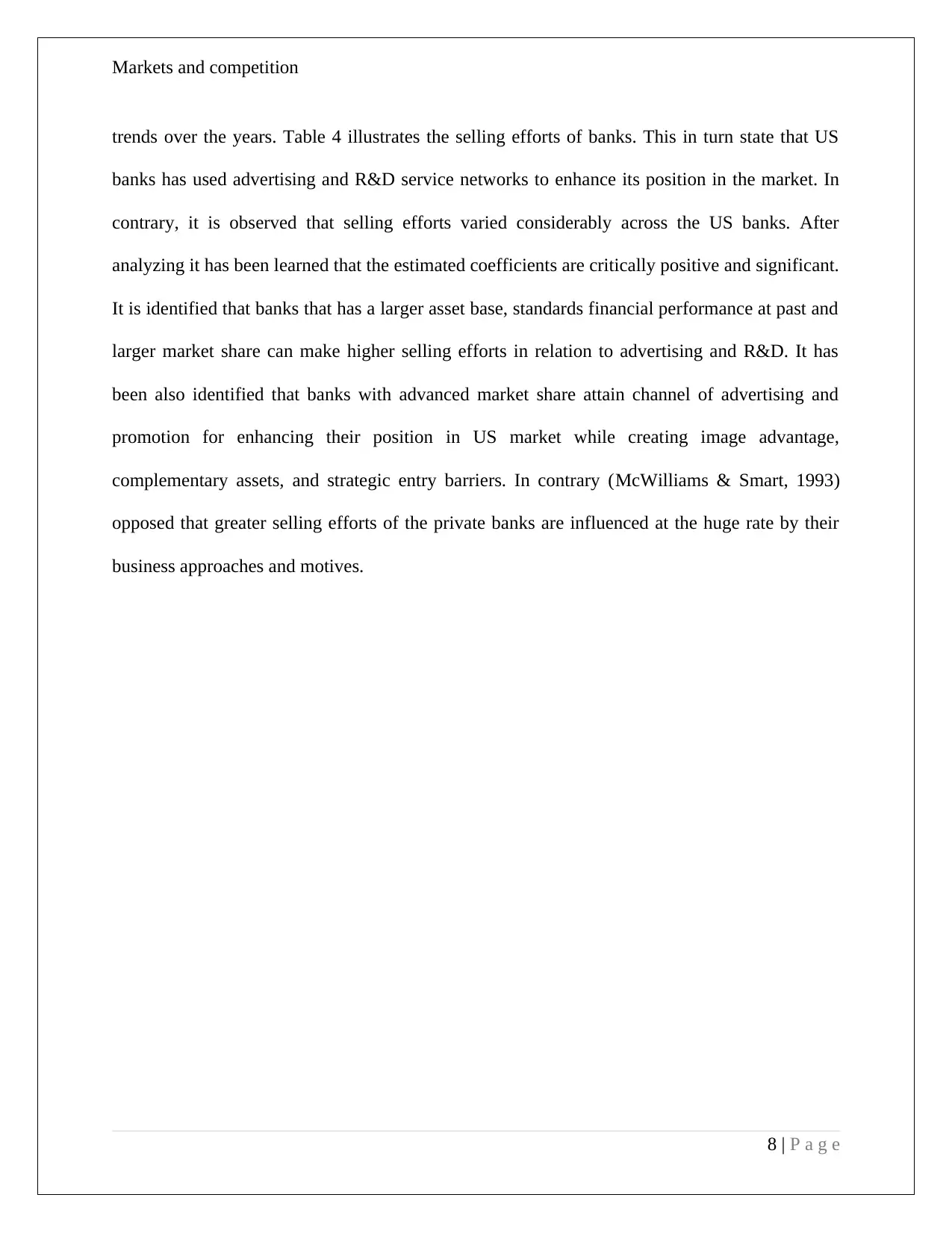
Markets and competition
trends over the years. Table 4 illustrates the selling efforts of banks. This in turn state that US
banks has used advertising and R&D service networks to enhance its position in the market. In
contrary, it is observed that selling efforts varied considerably across the US banks. After
analyzing it has been learned that the estimated coefficients are critically positive and significant.
It is identified that banks that has a larger asset base, standards financial performance at past and
larger market share can make higher selling efforts in relation to advertising and R&D. It has
been also identified that banks with advanced market share attain channel of advertising and
promotion for enhancing their position in US market while creating image advantage,
complementary assets, and strategic entry barriers. In contrary (McWilliams & Smart, 1993)
opposed that greater selling efforts of the private banks are influenced at the huge rate by their
business approaches and motives.
8 | P a g e
trends over the years. Table 4 illustrates the selling efforts of banks. This in turn state that US
banks has used advertising and R&D service networks to enhance its position in the market. In
contrary, it is observed that selling efforts varied considerably across the US banks. After
analyzing it has been learned that the estimated coefficients are critically positive and significant.
It is identified that banks that has a larger asset base, standards financial performance at past and
larger market share can make higher selling efforts in relation to advertising and R&D. It has
been also identified that banks with advanced market share attain channel of advertising and
promotion for enhancing their position in US market while creating image advantage,
complementary assets, and strategic entry barriers. In contrary (McWilliams & Smart, 1993)
opposed that greater selling efforts of the private banks are influenced at the huge rate by their
business approaches and motives.
8 | P a g e
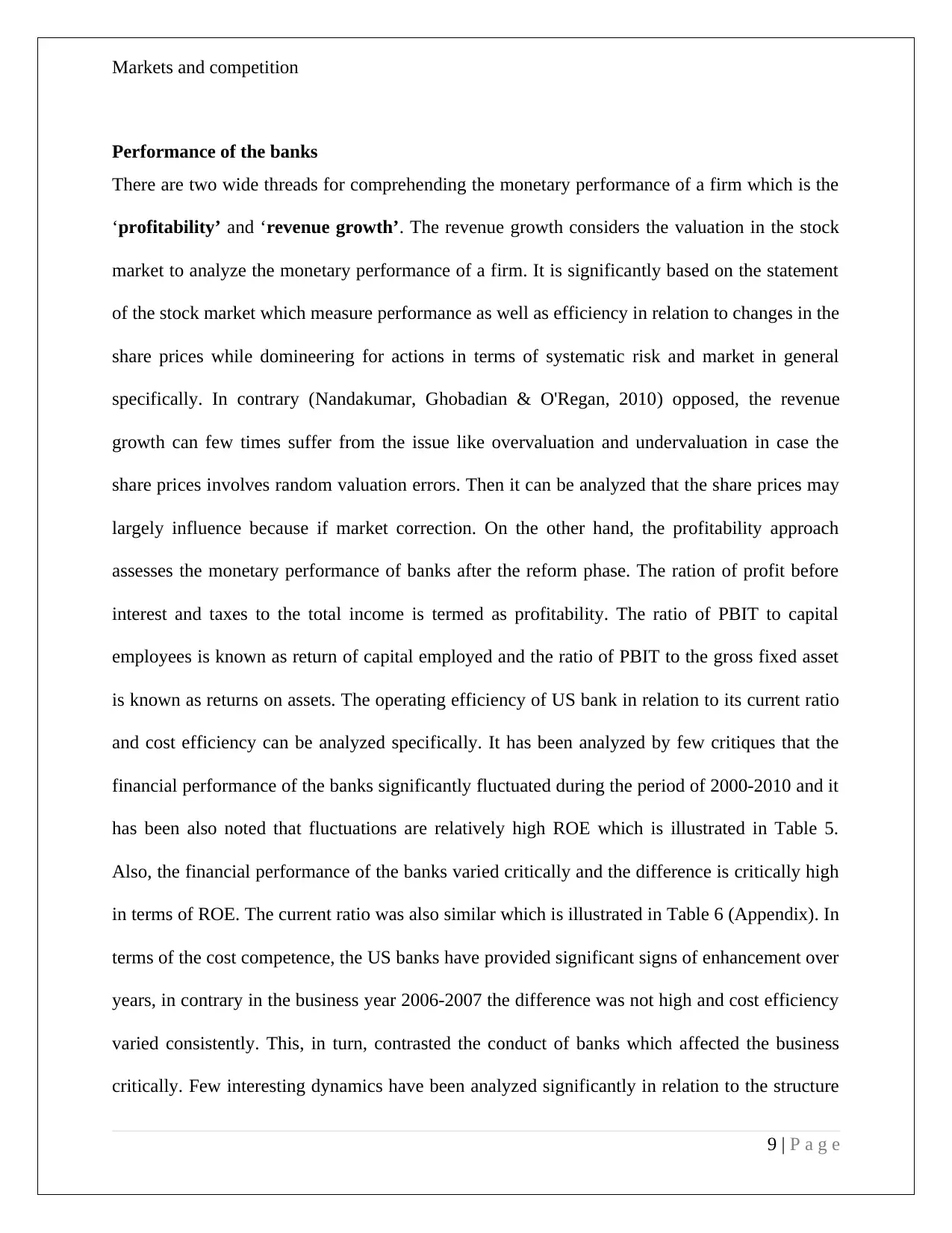
Markets and competition
Performance of the banks
There are two wide threads for comprehending the monetary performance of a firm which is the
‘profitability’ and ‘revenue growth’. The revenue growth considers the valuation in the stock
market to analyze the monetary performance of a firm. It is significantly based on the statement
of the stock market which measure performance as well as efficiency in relation to changes in the
share prices while domineering for actions in terms of systematic risk and market in general
specifically. In contrary (Nandakumar, Ghobadian & O'Regan, 2010) opposed, the revenue
growth can few times suffer from the issue like overvaluation and undervaluation in case the
share prices involves random valuation errors. Then it can be analyzed that the share prices may
largely influence because if market correction. On the other hand, the profitability approach
assesses the monetary performance of banks after the reform phase. The ration of profit before
interest and taxes to the total income is termed as profitability. The ratio of PBIT to capital
employees is known as return of capital employed and the ratio of PBIT to the gross fixed asset
is known as returns on assets. The operating efficiency of US bank in relation to its current ratio
and cost efficiency can be analyzed specifically. It has been analyzed by few critiques that the
financial performance of the banks significantly fluctuated during the period of 2000-2010 and it
has been also noted that fluctuations are relatively high ROE which is illustrated in Table 5.
Also, the financial performance of the banks varied critically and the difference is critically high
in terms of ROE. The current ratio was also similar which is illustrated in Table 6 (Appendix). In
terms of the cost competence, the US banks have provided significant signs of enhancement over
years, in contrary in the business year 2006-2007 the difference was not high and cost efficiency
varied consistently. This, in turn, contrasted the conduct of banks which affected the business
critically. Few interesting dynamics have been analyzed significantly in relation to the structure
9 | P a g e
Performance of the banks
There are two wide threads for comprehending the monetary performance of a firm which is the
‘profitability’ and ‘revenue growth’. The revenue growth considers the valuation in the stock
market to analyze the monetary performance of a firm. It is significantly based on the statement
of the stock market which measure performance as well as efficiency in relation to changes in the
share prices while domineering for actions in terms of systematic risk and market in general
specifically. In contrary (Nandakumar, Ghobadian & O'Regan, 2010) opposed, the revenue
growth can few times suffer from the issue like overvaluation and undervaluation in case the
share prices involves random valuation errors. Then it can be analyzed that the share prices may
largely influence because if market correction. On the other hand, the profitability approach
assesses the monetary performance of banks after the reform phase. The ration of profit before
interest and taxes to the total income is termed as profitability. The ratio of PBIT to capital
employees is known as return of capital employed and the ratio of PBIT to the gross fixed asset
is known as returns on assets. The operating efficiency of US bank in relation to its current ratio
and cost efficiency can be analyzed specifically. It has been analyzed by few critiques that the
financial performance of the banks significantly fluctuated during the period of 2000-2010 and it
has been also noted that fluctuations are relatively high ROE which is illustrated in Table 5.
Also, the financial performance of the banks varied critically and the difference is critically high
in terms of ROE. The current ratio was also similar which is illustrated in Table 6 (Appendix). In
terms of the cost competence, the US banks have provided significant signs of enhancement over
years, in contrary in the business year 2006-2007 the difference was not high and cost efficiency
varied consistently. This, in turn, contrasted the conduct of banks which affected the business
critically. Few interesting dynamics have been analyzed significantly in relation to the structure
9 | P a g e
⊘ This is a preview!⊘
Do you want full access?
Subscribe today to unlock all pages.

Trusted by 1+ million students worldwide
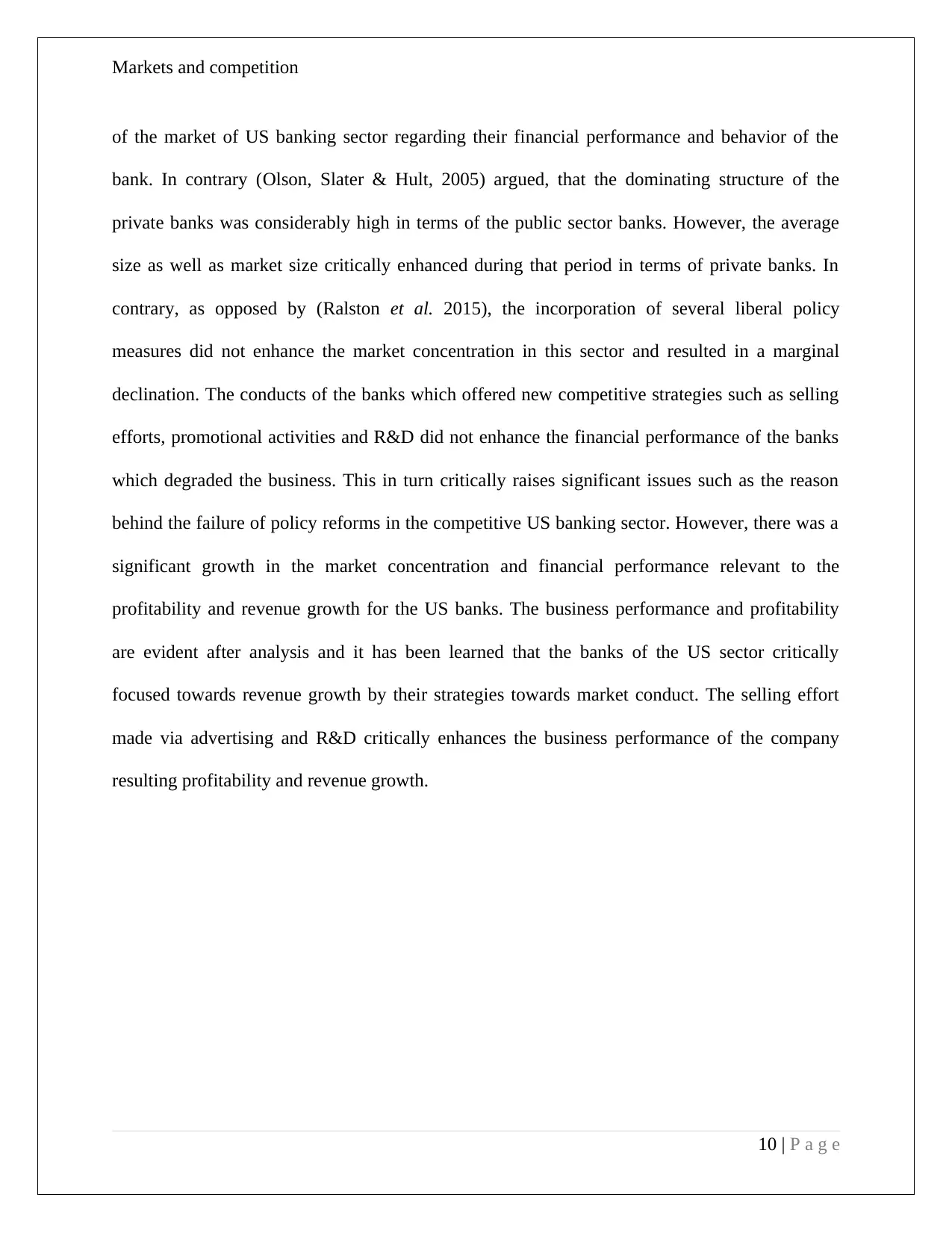
Markets and competition
of the market of US banking sector regarding their financial performance and behavior of the
bank. In contrary (Olson, Slater & Hult, 2005) argued, that the dominating structure of the
private banks was considerably high in terms of the public sector banks. However, the average
size as well as market size critically enhanced during that period in terms of private banks. In
contrary, as opposed by (Ralston et al. 2015), the incorporation of several liberal policy
measures did not enhance the market concentration in this sector and resulted in a marginal
declination. The conducts of the banks which offered new competitive strategies such as selling
efforts, promotional activities and R&D did not enhance the financial performance of the banks
which degraded the business. This in turn critically raises significant issues such as the reason
behind the failure of policy reforms in the competitive US banking sector. However, there was a
significant growth in the market concentration and financial performance relevant to the
profitability and revenue growth for the US banks. The business performance and profitability
are evident after analysis and it has been learned that the banks of the US sector critically
focused towards revenue growth by their strategies towards market conduct. The selling effort
made via advertising and R&D critically enhances the business performance of the company
resulting profitability and revenue growth.
10 | P a g e
of the market of US banking sector regarding their financial performance and behavior of the
bank. In contrary (Olson, Slater & Hult, 2005) argued, that the dominating structure of the
private banks was considerably high in terms of the public sector banks. However, the average
size as well as market size critically enhanced during that period in terms of private banks. In
contrary, as opposed by (Ralston et al. 2015), the incorporation of several liberal policy
measures did not enhance the market concentration in this sector and resulted in a marginal
declination. The conducts of the banks which offered new competitive strategies such as selling
efforts, promotional activities and R&D did not enhance the financial performance of the banks
which degraded the business. This in turn critically raises significant issues such as the reason
behind the failure of policy reforms in the competitive US banking sector. However, there was a
significant growth in the market concentration and financial performance relevant to the
profitability and revenue growth for the US banks. The business performance and profitability
are evident after analysis and it has been learned that the banks of the US sector critically
focused towards revenue growth by their strategies towards market conduct. The selling effort
made via advertising and R&D critically enhances the business performance of the company
resulting profitability and revenue growth.
10 | P a g e
Paraphrase This Document
Need a fresh take? Get an instant paraphrase of this document with our AI Paraphraser
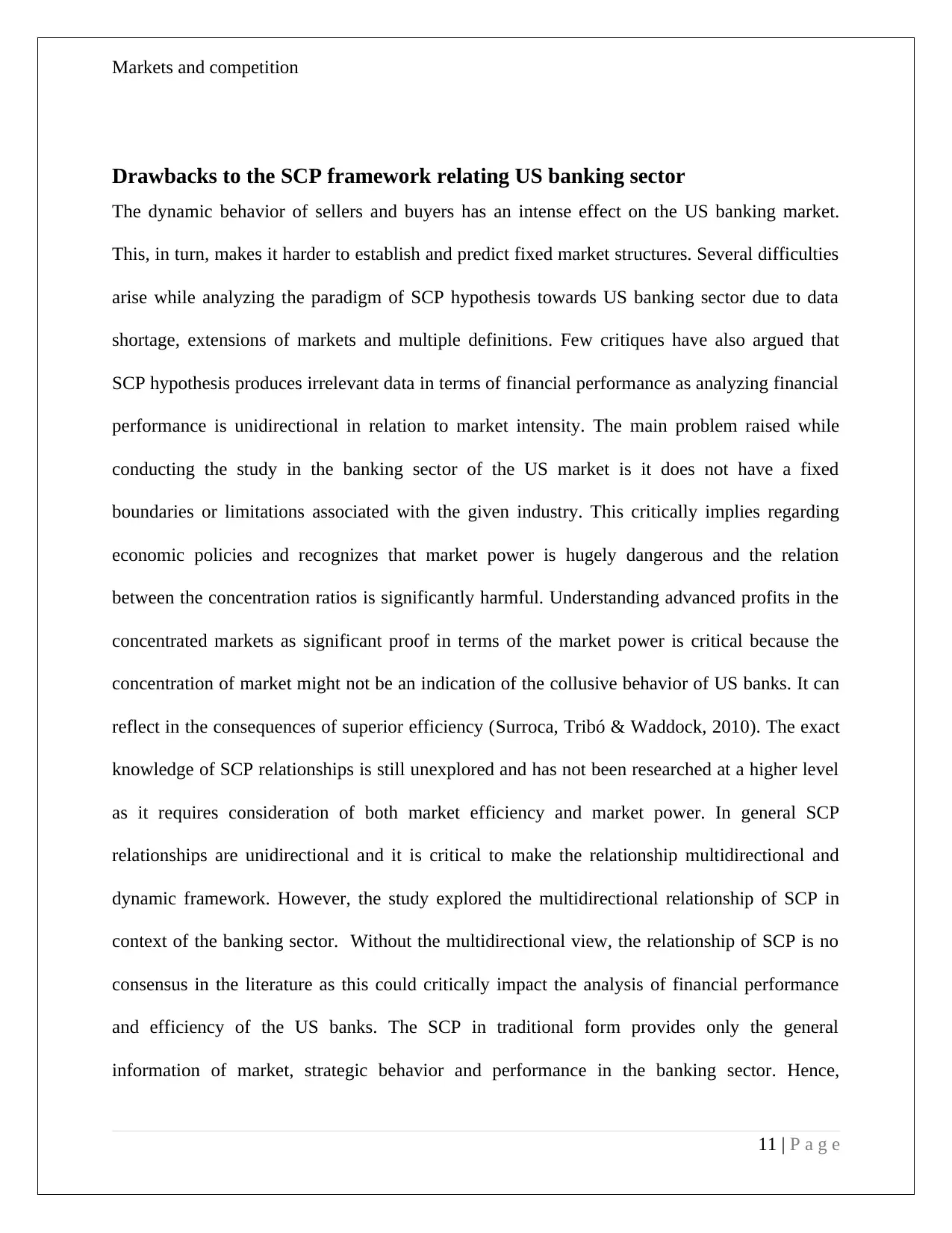
Markets and competition
Drawbacks to the SCP framework relating US banking sector
The dynamic behavior of sellers and buyers has an intense effect on the US banking market.
This, in turn, makes it harder to establish and predict fixed market structures. Several difficulties
arise while analyzing the paradigm of SCP hypothesis towards US banking sector due to data
shortage, extensions of markets and multiple definitions. Few critiques have also argued that
SCP hypothesis produces irrelevant data in terms of financial performance as analyzing financial
performance is unidirectional in relation to market intensity. The main problem raised while
conducting the study in the banking sector of the US market is it does not have a fixed
boundaries or limitations associated with the given industry. This critically implies regarding
economic policies and recognizes that market power is hugely dangerous and the relation
between the concentration ratios is significantly harmful. Understanding advanced profits in the
concentrated markets as significant proof in terms of the market power is critical because the
concentration of market might not be an indication of the collusive behavior of US banks. It can
reflect in the consequences of superior efficiency (Surroca, Tribó & Waddock, 2010). The exact
knowledge of SCP relationships is still unexplored and has not been researched at a higher level
as it requires consideration of both market efficiency and market power. In general SCP
relationships are unidirectional and it is critical to make the relationship multidirectional and
dynamic framework. However, the study explored the multidirectional relationship of SCP in
context of the banking sector. Without the multidirectional view, the relationship of SCP is no
consensus in the literature as this could critically impact the analysis of financial performance
and efficiency of the US banks. The SCP in traditional form provides only the general
information of market, strategic behavior and performance in the banking sector. Hence,
11 | P a g e
Drawbacks to the SCP framework relating US banking sector
The dynamic behavior of sellers and buyers has an intense effect on the US banking market.
This, in turn, makes it harder to establish and predict fixed market structures. Several difficulties
arise while analyzing the paradigm of SCP hypothesis towards US banking sector due to data
shortage, extensions of markets and multiple definitions. Few critiques have also argued that
SCP hypothesis produces irrelevant data in terms of financial performance as analyzing financial
performance is unidirectional in relation to market intensity. The main problem raised while
conducting the study in the banking sector of the US market is it does not have a fixed
boundaries or limitations associated with the given industry. This critically implies regarding
economic policies and recognizes that market power is hugely dangerous and the relation
between the concentration ratios is significantly harmful. Understanding advanced profits in the
concentrated markets as significant proof in terms of the market power is critical because the
concentration of market might not be an indication of the collusive behavior of US banks. It can
reflect in the consequences of superior efficiency (Surroca, Tribó & Waddock, 2010). The exact
knowledge of SCP relationships is still unexplored and has not been researched at a higher level
as it requires consideration of both market efficiency and market power. In general SCP
relationships are unidirectional and it is critical to make the relationship multidirectional and
dynamic framework. However, the study explored the multidirectional relationship of SCP in
context of the banking sector. Without the multidirectional view, the relationship of SCP is no
consensus in the literature as this could critically impact the analysis of financial performance
and efficiency of the US banks. The SCP in traditional form provides only the general
information of market, strategic behavior and performance in the banking sector. Hence,
11 | P a g e

Markets and competition
modified SCP has to be incorporated in the literature that incorporates market imperfections
arising from uncertainties functioning of the market, business costs and information costs into
fundamental market circumstances, asymmetric information as well as market that have an
important force on arrangement of the tactical behaviour of the banks, banking sector, and its
performance. This basic condition critically affects the public policies, market structure and
conduct performance against market failures (Tung, Lin & Wang, 2010). Hence, incorporating
modified SCP relationship was critical in the study; however, with the help of scholarly journals,
the study has been completed successfully. It is evident that there are several drawbacks
associated with the SCP framework while conducting the study on the banking sector of US but
traditional SCP and the assumptions analysed is the major one. However, relevant information
and critical theories acknowledged by several critiques have assisted towards analyzing the
market of US banking sector.
12 | P a g e
modified SCP has to be incorporated in the literature that incorporates market imperfections
arising from uncertainties functioning of the market, business costs and information costs into
fundamental market circumstances, asymmetric information as well as market that have an
important force on arrangement of the tactical behaviour of the banks, banking sector, and its
performance. This basic condition critically affects the public policies, market structure and
conduct performance against market failures (Tung, Lin & Wang, 2010). Hence, incorporating
modified SCP relationship was critical in the study; however, with the help of scholarly journals,
the study has been completed successfully. It is evident that there are several drawbacks
associated with the SCP framework while conducting the study on the banking sector of US but
traditional SCP and the assumptions analysed is the major one. However, relevant information
and critical theories acknowledged by several critiques have assisted towards analyzing the
market of US banking sector.
12 | P a g e
⊘ This is a preview!⊘
Do you want full access?
Subscribe today to unlock all pages.

Trusted by 1+ million students worldwide
1 out of 22
Related Documents
Your All-in-One AI-Powered Toolkit for Academic Success.
+13062052269
info@desklib.com
Available 24*7 on WhatsApp / Email
![[object Object]](/_next/static/media/star-bottom.7253800d.svg)
Unlock your academic potential
Copyright © 2020–2026 A2Z Services. All Rights Reserved. Developed and managed by ZUCOL.





